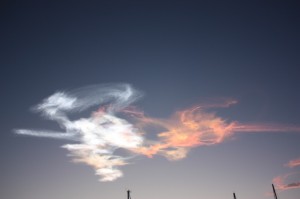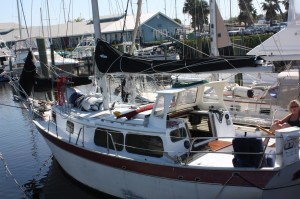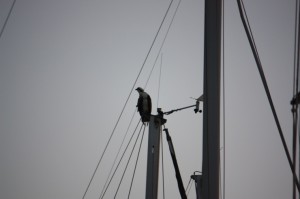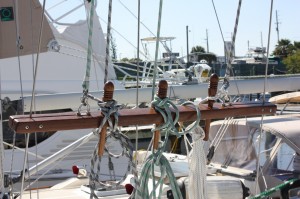By Bill Amt and Diane Redinger
On April 3rd 2010, Saffanah started the second leg of her voyage from Marathon FL to Jacksonville FL where she will undergo the many remaining projects associated with her restoration. Her first leg from the keys to Ft Pierce in December was more entertaining than the recent trip this past week. This trip was pleasant and comfortable, incorporated great weather, lucked out in nearly perfect timing for winds, tides and moon light, and included a view of the last night time Shuttle launch – a spectacular event. And crew compatibility was definitely not an issue – my best friend, perfect sailing companion, and wife, Diane, was with me for the first time on Saffanah.
| The shuttle’s exhaust trail being dispersed as the sun rose over Titusville – 4/4/2010 |
Unfortunately, as is the case most of the sailing time I have ever experienced, this trip offered little intrigue about which to write – no emergencies or heart stopping events, no great sea stories that can be further elaborated over time, just five days of five knot motor sailing in light air, under azure blue skies, punctuated with white puffy clouds and plenty of shore color provided by azalea, dogwood, and redbud blossoms. Is it not odd that the most idyllic passages offer the least about which to write?
When Saffanah arrived in Ft Pierce in December, we had new canvas made to protect the new sails we had purchased in the fall. And because Mack Sails is located in nearby Stewart, we elected to purchase a Mack-Pac (sail cover and integrated lazy jack system). While measuring the boom and mast, the Mack riggers discovered a badly cracked spreader and a damaged port stay turnbuckle. As a result, they strongly advised that we not sail the boat again without first addressing these two problems.
| Saffanah’s new canvas and Mack Pack |
As luck would have it, the DYI yard at Harbortown closed the day before Mack surveyed the rigging and we had either to travel back down the ICW to Stewart to have the mast un-stepped or motor 250 miles up the ICW and do the work in our Jacksonville home port. We decided to travel up the ICW and just use the jib to pull us along if we had a southerly breeze.
After waiting out the chilly and rainy winter months as long as we could tolerate, we decided to leave Ft Pierce on Easter weekend – come rain or shine. As luck would have it, a stationary high stalled over central Florida the day we left and brought spring-like 5 – 10 knot southerly light air for the next five days.
| An osprey on the mast in Titusville |
The trip up the inter-coastal waterway is nearly a straight shot north through the Indian, Banana and Halifax rivers punctuated with just enough east-to-west/west-to-east jogs and narrow channel and shallow-water twists and turns to make the task of spotting red and green day beacons a tiny bit tedious. That tedium coupled with a constant stream of fishermen racing to their favorite hole, a wide collection of randomly placed crab pots (that often means randomly placed IN the channel), a bunch of Bahamas snow birds heading back to their summer Chesapeake and Maine homes in their sail boats and trawlers, and an occasional sixty foot motor yacht delivery, made a seemingly leisurely five knot per hour pace a lot of work. By the way, there are no less than 103 bridges between Miami and the Ortega River in Jacksonville, well spaced to disperse any potential “monotony anxiety” one might conjure up. And just to add a bit more challenge, Einstein, our Garmin 3210 GPS, unexpectedly decided to take the week off, so we had to travel the old fashioned way, using paper charts and binoculars to track our hourly progress.
In addition, my permanent traveling partner (my wife Diane) had never stepped onto a sailboat nor navigated the ICW before this trip. Further, she had never seen (let alone steered with) a tiller before departing Fort Pierce – so helmsmanship training further reduced the potential for monotony. Also, on-the-job-training (OJT) on docking and undocking, reading chart symbols, hailing bridges, etc. added spice and variety to our otherwise active daily regiman – no classroom instruction, coast guard course, beforehand.
So our trip north could be more appropriately described as a “task” than a leisurely “trip up the ditch”.
But any effort spent or anxiety experience was definitely offset with spectacular views of ocean inlets, salt water marshes, gorgeous homes and estates, and wild life galore. And, while definitely a passage off shore along the coast line would have been a lot less challenging and less expensive, the ICW continues to hold a fond and dear place in this sailor’s heart.
Without GPS (Einstein) and radar, travel at night on the ICW is too much a risk for this sailor who gets uncomfortable in less than 100 fathoms of water or when the nearest coast line is less than 100 mile away. Daily progress had to be measured and planned by the distance between anchorages and marinas and adjusted to fit with scheduled bridge openings. Oh by the way, Saffanah’s anchor platform was broken during the trip up to Ft Pierce so anchoring was not going to be in our play book during this trip – only the good but expensive marina life for us – what a shame – that would have allowed us to extend the daily distance traveled considerably.
So forty or fifty mile days – determined by the destination – set the pace – an average of 6.1 mph including wait time at bridges, backtracking a few wrong turns, and long runs against (or with) the always present tides and river currents.
| Day | Departed | Arrived | Distance Traveled | Time | Best and worst parts of the day |
| Sat April 3 | Ft Pierce
7:30 AM |
Melbourne
2:00 PM |
47 statute miles | 6.5 hours | Best – beautiful sunrise, great weather – excited to get going.
Worst – really nothing at all |
| Sun April 4 | Melbourne 7:30 AM | Titusville
3:00 PM |
40 statute miles | 7.5 hours | Best – great wildlife birds and lots and lots of dolphins and a couple of manatees
Worst – again really nothing. Had to power against an 2 knot outgoing tide for first few hours – no big deal |
| Mon April 5 | Titusville
7:30 AM |
Daytona Beach – 4:00 PM | 48 Statute miles | 8.5 hours | Best – saw the last nighttime shuttle launch – spectacular!
Worst – a day late and a dollar short on every bridge opening Worster – got lost in Ponce Inlet and had to back track to the ICW – where was Einstein when we needed him? Worstest – Left Marina at 7:30 AM ahead of at least a dozen other sailboats – all of which passed us and were out of sight by 9:30 AM. Saffanah is definitely under-powered and a first class ICW slowpoke |
| Tues April 6 | Daytona Beach
7:00 AM |
St Augustine
4:00 PM |
55 Statute Miles | 9.5 hours | Best – my growing confidence that Saffanah’s rebuilt engine, while undersized for her displacement, was now a proven workhorse and definitely a keeper.
Worst – more bridge delays – we were forever a day late and a dollar short when it comes to hitting the published bridge opening schedule |
| Wed April 7 | St Augustine
7:00 AM |
Ortega River Landing – Jacksonville
7:00 PM |
53 statute Miles | 12 hours | Best – could not have timed the entrance to the St Johns river better – even if I had planned it. Hit the ICW/St John’s intersection at slack tide with high tide down-stream four hours later Worst – missed the rush hour traffic Main Street bridge closing in Downtown Jacksonville by five minutes and had to idle for two hours – wasting the perfect timing at the Ortega River’s entrance and making the final five miles to the Ortega River very hair-raising, considering a sudden easterly 25 knot wind, three foot waves and a final three mile, local knowledge jaunt directly into the setting sun in less than 6 feet of water |
Oh, lest I forget, we did have a moment or two of high anxiety. Our chosen home port marina’s insurance underwriter requires ALL boats to dock stern in to the new floating docks. As we arrived at our new marina, the tide was beginning to flood with the two knot Ortega River current and the 25 knot wind, of course. was blowing against the combined current and tide. And of course, the slip chosen was on the downstream of the current and upwind side of the 25 knot wind.
Just to add a little more spice to the soup, the dock master decided that we should go directly to our assigned slip before dark – rather than allowing us to pull to the transient dock for a moment to gain an understanding of where he wanted us to go or figuring how we were going to do what he wanted. He also recruited an audience of 10 or so locals to watch how a skilled blue water sailor singlehandedly brings his full keel, tiller directed, heavy displacement sailing vessel into the slip – regardless of the sea conditions. A couple of hours later and with the help of the 10 locals, two dinghys and six dock lines, Saffanah was safely in her new home – no damages to the surrounding boats, only severe damage to my ego and reputation.
During the trip from Marathon to Ft Pierce, I learned the well documented discomfort of the Downeast cockpit was definitely not a figment of anyone’s imagination. So during a routine trip to West Marine. Diane addressed this complaint by purchasing two folding, over-padded, deck chairs, and the cockpit discomfort was no longer an issue.
| Folding five position chairs from West Marine and Saffanah’s nifty but cheap cockpit grate |
Also, the photo to the left shows the cockpit grate we fabricated from some scrap ¾’ teak strips.
| Pin rail and belaying pins for Saffanah |
If anyone is interested, I will post the drawing that I used to make the grate. I bought the scrap teak on eBay for $26 and took a long afternoon to build it. Another couple of hours of sanding and varnishing created a cockpit grate a local yard offered to make for me for just shy of $750.
We also made a set of pinrails with belaying pins for Saffanah. once again out of scrap teak purchased off the internet – one man’s trash is certainly another man’s treasure. Again, about $50 worth of eBay teak to produce something a yard was willing to do for a sacrificial price of $225 per pinrail.
Bill and Diane
SV Saffanah






Recent Comments